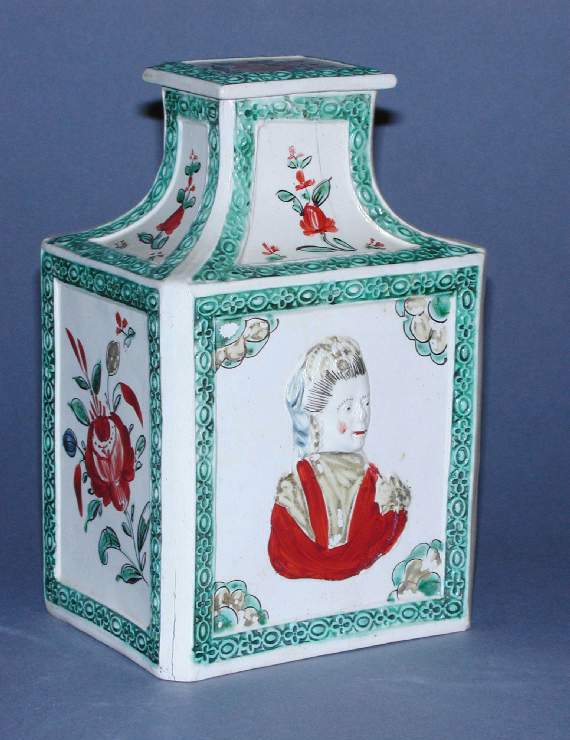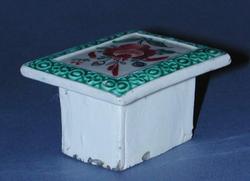Current Location: In storage
Maker(s)
uncertain
Entities
Categories
Description
Creamware, moulded, with applied reliefs and rouletted (?) borders, painted overglaze in blue, green, yellow, red, and black enamels. Rectangular in plan with straight sides, in-curved shoulders and a flat rectangular cover, The edges of the sides, the in-curved shoulder, and the edges of the cover have narrow border sof alternating quatrefoil and oval motifs in relief painted green. On one of the long sides there is a relief bust of George III and on the other of Queen Charlotte (the relief below the head missing) painted in polychrome enamels, and in each corner a quarter of a petalled flowerhead in green and yellow. The two short sides, and the top of the cover are painted with a red rose spray and other buds and leaves. The four shoulders have a floral spray and two sprigs in red and green.
Notes
History note: Mr Parkin of Waterloo Road, Brighton Hove (unclear which) from whom purchased for £8.5s.0d. on 20 October 1920 by Dr J.W.L. Glaisher, FRS. Trinityu College, Cambridge
Legal notes
Dr J. W. L. Glaisher Bequest
Measurements and weight
Height: 16.5 cm
Width: 10.2 cm
Acquisition and important dates
Method of acquisition: Bequeathed
(1928)
by
Glaisher, J. W. L., Dr
Dating
18th Century, Late
Production date:
circa
AD 1780
: The canister probably dates from about 1780 as a comparable example without the borders on the shoulders in a private collection is dated 1781.
Note
George III ruled from 1760 to 1820. He married Princesss Charlotte of Mecklenburg-Strelitz in 1761.
Several cramware caddies of this rectangular form with a sloping neck and flat cover are recorded. A plain example was formerly in the Chicago Institute of Art; two painted underglaze in blue with chinoiseries is in the Victoria and Albert Museum; and another, lacking the borders on the shoulders, and painted in enamels with flowers, and dated '1781' is in a private collection. See Documentation, Walford, 2011. Rackham (1935) attributed the canister uncertainly to Leeds, but Walford considers that attribution to one of the north east of England potteries was a possibility.
People, subjects and objects depicted
Components of the work
Decoration
composed of
enamel
( grey-blue, green, yellow, red, and black)
Borders
Reliefs
Materials used in production
Lead-glaze
Creamware
Techniques used in production
Moulding
Lead-glazing
Inscription or legends present
Inscription present: rectangular paper label with blue line border
- Text: No. 3794/Leeds oblong/tea caddy and/cover with/relief portraits/ofGeorge III/and Qu Charlotte/bt in Bighton/Oct 20 1920
- Location: On base
- Method of creation: Hand-written in black ink
- Type: Label
References and bibliographic entries
Identification numbers
Accession number: C.1058 & A-1928
Primary reference Number: 71243
Old object number: 3794
Stable URI
Audit data
Created: Saturday 6 August 2011
Updated: Tuesday 30 April 2024
Last processed: Tuesday 15 July 2025
Associated departments & institutions
Owner or interested party:
The Fitzwilliam Museum
Associated department:
Applied Arts








